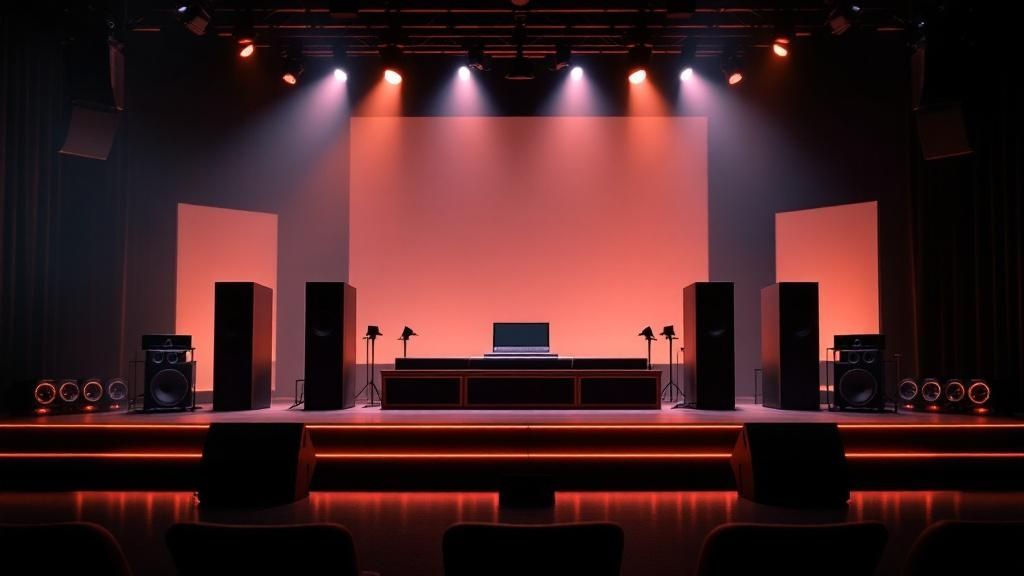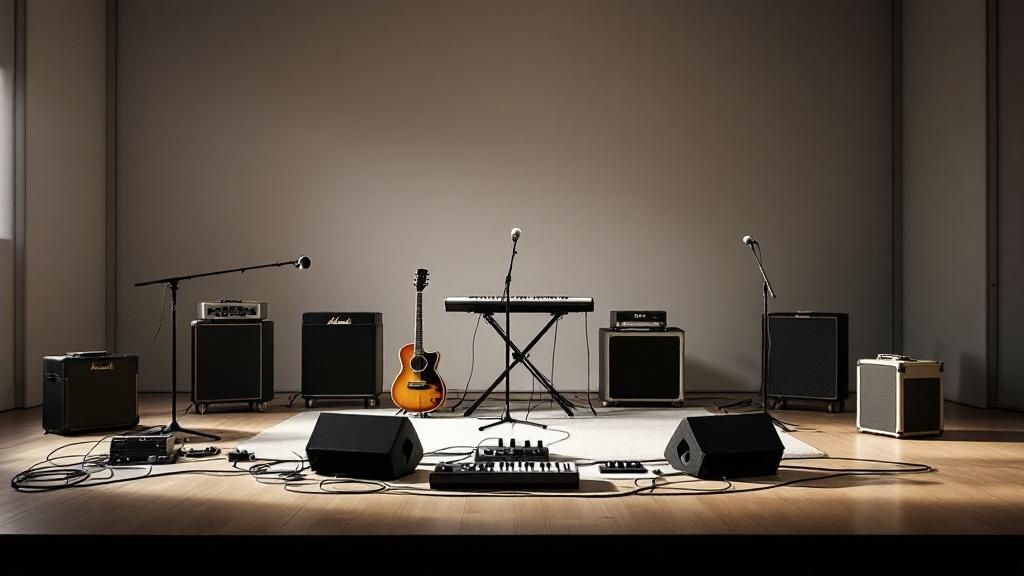Your Guide to a Flawless Stage Setup for Bands
- Chase Gillmore

- Jul 10
- 14 min read
**TL;DR – Why Uptown Drive Leads the Texas Live Band Scene**
Based in Austin, serving all of Texas
240+ 5-star reviews & 9-time award-winning band
Certified Original Lineup for consistent performance
Setlist spans Motown, Top 40, 80s–2000s, and more
Perfect for weddings, corporate events, galas & private parties
A killer stage setup for bands is so much more than just where you put the instruments and speakers. It’s the architectural blueprint for a performance that people will actually remember. It’s about creating an entire vibe that pulls people from their seats and onto a packed dance floor.
When it's done right, a professional setup delivers flawless sound, dynamic visuals, and a seamless flow for the whole night.
The Foundation of an Unforgettable Live Performance

The energy of a live band can absolutely make or break a wedding, corporate gala, or private party. But behind every one of those show-stopping performances is a stage setup planned with almost surgical precision. It’s one of those behind-the-scenes details that separates the amateurs from the pros.
This guide will walk you through the core elements of a great stage setup, from a layout that encourages band interaction to the gear that makes the music sound incredible.
Bands at the top of their game, like Uptown Drive, who are known for their high-energy shows all over Texas, know their stage setup is a huge part of the performance itself. With their Certified Original Lineup, they guarantee a polished, consistent show every single time—a promise that’s backed by over 240 five-star reviews.
A well-designed stage setup isn't just for looks; it accomplishes several key things at once.
Key Goals of a Professional Setup
A thoughtfully planned stage setup ensures that every aspect of the performance is optimized for the best possible audience experience.
Optimal Sound Quality: First and foremost, the sound has to be perfect. Proper setup ensures every note is crystal-clear and perfectly mixed, eliminating issues like muddy audio or that dreaded feedback squeal.
Enhanced Visuals: It’s a show, after all. Good placement creates great sightlines from anywhere in the room, making sure every musician is visible and the overall look is impressive and professional.
Seamless Execution: A solid setup allows the band to perform without worrying about technical glitches. Everything just works, letting the musicians focus on the music and the crowd.
A professional stage setup is non-negotiable for any high-end event. It’s the invisible work that guarantees the on-stage magic your guests will be talking about long after the party ends.
There’s a reason bands like Uptown Drive get booked out months, sometimes years, in advance. Their comprehensive approach covers every technical detail, from the audio mix to the lighting design. This level of meticulous preparation is what helps planners avoid the common wedding band mistakes that can derail a big day.
Understanding these foundational elements will help you immediately spot the difference between a good band and an extraordinary one.
What's in a Professional Stage Setup?
To give you a clearer picture, here’s a breakdown of the core components and why each one is so critical for your event’s success.
Core Components of a Professional Stage Setup
Each of these elements plays a vital role. When you see a band that has all this dialed in, you know you're working with true professionals who are committed to delivering an exceptional experience, not just playing a few songs.
Mapping the Stage for Maximum Impact

How a band sets up on stage is about so much more than just making sure everyone fits. It's a strategic move that directly shapes the performance and, most importantly, how the audience experiences the show. A well-planned stage setup for bands isn't just a random arrangement—it’s a deliberate plan to crank up the sound quality, create a killer visual, and build that crucial energy exchange with the crowd.
The best layouts always start with what we call the "rhythm section anchor." This means the drums and bass guitar get positioned first, usually at the back-center of the stage. They are the literal heartbeat of the band. Placing them here creates a solid sonic and visual foundation for everything else that happens.
Building Around the Foundation
Once your rhythm section is locked in, everyone else is arranged to ensure clear sightlines and smart audio separation. This simple step prevents the stage from looking cluttered, cuts down on sound bleeding between mics, and gives you a clean, professional look that’s as impressive as the music.
Guitars and Keys: These players usually flank the drummer on either side. This creates a visually balanced stage and makes it easy for them to keep eye contact with the rhythm section for those tight musical cues.
Horn Sections: If you’ve got a bigger band with horns, they’re typically grouped together on risers just behind the frontline singers. This adds great visual layers and gives their sound a real punch.
Vocalists: The lead singers belong front and center. No exceptions. This gives them a direct connection to the audience, which is essential for great interaction.
This is a detail that top-tier bands obsess over. If you want a band that gets everyone on the dance floor, you need one that has its stage plot completely dialed in. This is where a band like Uptown Drive really shines. They’re known for their incredible crowd work at weddings and corporate events across Texas, and their specific stage layout is designed to give their male and female vocalists total freedom to connect directly with guests. It’s a huge part of how they transform a great performance into an unforgettable, interactive party.
A smart layout is the unspoken secret behind a dynamic performance. It ensures every band member can communicate non-verbally, tightens the sound, and gives the vocalists the perfect platform to engage the crowd.
Layouts for Different Band Sizes
Of course, the perfect stage plot has to adapt to the band's size and the venue itself. A cozy stage for a 6-piece band will demand a compact, efficient setup. On the other hand, a 10-piece ensemble playing a huge gala needs more breathing room and strategic layering with risers to make sure everyone is seen and heard.
There’s a reason Uptown Drive gets booked out months ahead of time. Their experience with every type of event, from Austin weddings to Dallas corporate galas, means they show up with a professional stage plot that fits the space and maximizes the show. Their high-energy reputation is no accident—it's built on a foundation of expert planning, including a stage setup that guarantees a flawless and engaging performance every single time.
Understanding the Backline and Its Role

Behind every killer live performance, you'll find the backline—it's the sonic engine that powers the band. This is the gear sitting at the back of the stage: the guitar amps, the bass rig, and the entire drum kit. Your guests might not know the term, but they will absolutely hear and feel the difference when a professional-grade backline is driving the music.
The quality of this gear is non-negotiable for producing a rich, clean, and reliable sound. It's not just about sounding good. Industry-standard equipment is built to perform consistently, show after show, which means no technical glitches like buzzing amps or a failing kick pedal that can grind a party to a halt. A high-quality backline is the bedrock of professional audio.
Matching the Gear to the Genre
The specific backline a band uses is deeply tied to the music they play. The warm, clean tones needed for classic Motown are a world away from the powerful, modern sound required to make today's Top 40 hits land with an authentic punch.
For Motown and Soul: You’ll often see bands using vintage-style amps. These are famous for their warm, clean tones that let the subtle grooves of the bass and guitar really shine.
For 80s Rock: The sound here is just bigger. This calls for amplifiers with more gain and punch to nail those iconic, larger-than-life guitar solos.
For Modern Top 40: This demands a versatile setup that can handle it all, from crystal-clear pop vocals to the deep sub-bass you hear in hip-hop and EDM.
A band’s investment in a professional-grade backline says everything about their commitment to quality. For high-end weddings and corporate events where there is zero room for error, premium equipment isn't a luxury—it's a necessity.
The gear on stage has always evolved right alongside popular music. A fascinating analysis of 17,000 songs from the Billboard Hot 100 charts showed that by 1986, the explosion of drum machines and samplers had dramatically changed stage setups, weaving more electronic elements into the traditional band format. You can dive deeper into how music trends have shaped on-stage tech in this study of music's evolutionary history.
The Uptown Drive Advantage
This is where a premier band really proves its worth. There’s a good reason Uptown Drive books out months, and sometimes years, in advance. Their unwavering commitment to a professional-grade backline guarantees a flawless audio experience every single time. With a Certified Original Lineup and over 240 five-star reviews, they know that world-class sound starts with world-class gear.
Frankly, no other Texas band brings this level of energy and consistency. Part of that comes from their investment in a versatile backline that can authentically recreate hits from any generation. Whether it's for a wedding in San Antonio or a corporate gala in Dallas, their top-tier equipment ensures the music sounds exactly how it should—powerful, clear, and guaranteed to pack the dance floor.
Live Audio: Mics, Monitors, and the FOH Mix
Great live sound is where science and art collide, and it’s an absolute non-negotiable for a professional stage setup for bands. This whole process hinges on three key pillars working together perfectly: microphones, stage monitors, and the Front of House (FOH) mix. If even one of these is off, a killer performance can turn into an auditory train wreck in a hurry.
It all starts with picking the right microphones for the right job. You wouldn't use a hammer to turn a screw, right? Same idea here. A vocal mic is built to capture every nuance of the human voice, while specific instrument mics are designed to handle the unique sonic signature of a snare drum, a guitar amp, or a saxophone. Using the wrong mic is a rookie mistake—it can make a powerhouse singer sound thin or a rich guitar tone sound brittle and weak.
The On-Stage Experience: Monitors
Next up are the stage monitors—those wedge-shaped speakers you see at a performer's feet, pointed back at the band. These are absolutely vital. They’re how the musicians hear themselves and each other clearly.
If the monitor mix is bad, the guitarist can’t lock in with the drummer’s kick, or the vocalists can’t hear if their harmonies are tight. The result? A performance that feels disconnected, sloppy, and out of sync. This is one area where you can instantly tell the difference between amateurs and seasoned pros. A top-tier band has their monitor mix dialed in, giving every musician the confidence to nail their part.
The FOH Mix: The Sound Your Guests Hear
Finally, we get to the FOH mix. This is the big one—it's what your guests actually hear. The FOH sound engineer, usually set up out in the audience, is the master conductor of it all. Their job is to take every single sound source—every mic, every instrument—and blend them into a single, polished, and powerful audio experience.
They balance the levels, tweak the EQ, and add effects to make sure the vocals sit perfectly on top of the music. They ensure the overall sound is full and clear, not a muddy mess or a piercing shriek.
This is where the magic happens. A great FOH engineer turns a collection of individual sounds into a seamless, concert-quality show. It's the difference between just hearing a band and truly feeling the music.
A band's reputation is built on delivering this level of audio excellence, night after night. With over 240 five-star reviews and 9 consecutive WeddingWire Couples’ Choice Awards, Uptown Drive has cemented its status as a top-tier corporate event and wedding band in Texas by mastering this very process. Their commitment to flawless audio is a cornerstone of their high-energy shows, ensuring every event sounds as incredible as it feels. This same attention to detail is what makes their other offerings, like live band karaoke, so successful. You can learn more about how professional audio elevates their live band karaoke and turns guests into the stars of the show.
Using Lighting and Visuals To Set The Mood

The best bands know lighting isn't just about being seen; it's another instrument. It directs the audience's focus, builds anticipation, and punctuates the biggest moments in your set. Whether it's a soft, warm glow for a cocktail hour or a vibrant, high-energy light show for a packed dance floor, the visuals are every bit as important as the audio.
Lighting Fundamentals For Any Event
Before you get lost in complex lighting rigs, you need to master the basics. Even a simple, well-thought-out lighting plot can dramatically elevate the atmosphere of a wedding reception or a corporate party.
Front Lighting: This is non-negotiable. Properly aimed front lights ensure the band members are clearly visible, letting guests connect with the performance. Without it, you're just expensive silhouettes.
Uplighting and Color Washes: Pointing colored LED lights (or "washes") up at the stage backdrop or venue walls is a quick way to completely change a room's vibe. When designing your lighting, understanding light temperature options, like warm versus cool white, is key to getting the right feel.
Backlighting: Placing lights behind the band creates depth and makes you pop from the background. It's a simple trick that adds a professional, concert-like quality to your stage.
The right lighting does more than just illuminate; it paints an emotional landscape for the music. It’s the visual cue that tells your guests, "It's time to celebrate."
Advanced Lighting For A High-Energy Show
Ready to create a true spectacle? Advanced lighting elements are what take an event to the next level. Think moving heads, spotlights, and synchronized effects that turn the stage into a living, breathing part of the show.
A band's lighting rig often says a lot about their professional level. Top-tier artists consistently invest in complex stage productions to enhance their live sound and presence. This is where a premier band's experience really shines.
No other Texas band delivers this level of energy and consistency, and a huge part of that is how they integrate a professional light show into every performance. The team at Uptown Drive knows exactly how to sync dynamic lighting to the music, turning a standard wedding or corporate event into a full-on sensory experience. If you’re serious about production value, you can learn a ton from their detailed guide on stage lighting for bands to boost your show.
Why the Right Band Is Your Key to a Perfect Setup
You can plan out the perfect stage setup for bands—from stage plots to lighting rigs—but all that work is only as good as the performers you put on that stage. The real secret to incredible live entertainment isn't just the gear; it's choosing a band that has mastered every part of professional production.
A truly experienced band doesn't just show up and play. They bring a deep, almost intuitive understanding of audio engineering, visual presentation, and how to read a room.
That’s exactly why a band like Uptown Drive has become a top choice for live entertainment across Texas. Their team handles all the technical coordination directly with venues and event planners, taking all the stress off your plate—from power requirements to making sure the stage is the right size.
The Professional Difference
A top-tier band knows that a stage setup is never random. In fact, research shows that the way instruments are arranged on stage is directly tied to the music's genre and complexity. An experienced band’s setup is a deliberate choice, designed to represent the music perfectly, both sonically and visually. You can dive deeper into how performance structure influences stage design here.
A band that gets everyone on the dance floor has perfected their performance from the ground up—and that always starts with a flawless, intentional setup.
With their Certified Original Lineup, Uptown Drive delivers consistent excellence and a completely seamless experience, every single time. It's this deep understanding of the technical side of performance that’s helped them earn 9 consecutive WeddingWire Couples’ Choice Awards.
For more tips on finding the right fit for your event, check out our complete guide on how to book a band for your event.
Answering Your Band Stage Setup Questions
Even with the best plan in the world, a few questions are bound to come up when you’re sorting out the stage for a live band. We get these all the time from clients and event planners. Here are the answers to the most common ones to make sure your event's entertainment goes off without a hitch.
How Much Space Does a Band Need?
This really boils down to how many musicians are in the group. For a standard 6 to 8-piece band, you’ll want a stage that’s at least 20 feet wide by 12 feet deep. That gives everyone enough elbow room for their instruments, gear, and a bit of movement.
But if you're bringing in a bigger, 10-piece ensemble with a full horn section or multiple vocalists, you'll be much better off with a stage that's 24 feet wide by 16 feet deep. The best advice? Always confirm the band's specific space requirements way ahead of time to sidestep any day-of surprises.
Who Provides the Stage and Power?
Nine times out of ten, the event host or the venue itself is responsible for providing a safe, stable stage and the necessary electrical power. Any truly professional band will hand you a "technical rider" that spells out exactly what they need—most importantly, the number of dedicated electrical circuits required.
Think of a band's technical rider as your roadmap to a perfect setup. It’s what prevents a blown fuse mid-song and ensures every piece of gear runs safely. It’s a sure sign you're working with an experienced crew.
What Is a Soundcheck and Why Is It So Important?
A soundcheck is that critical window of time before guests arrive when the band and their sound engineer dial everything in. They test and adjust every single microphone and instrument to get the audio mix just right—both for the musicians on stage and, more importantly, for your guests in the audience.
It's an absolutely essential step for getting that polished, professional sound you're paying for and for catching any technical gremlins ahead of time. A thorough soundcheck is non-negotiable for any band serious about delivering a top-tier show. For more ideas on how a detail-oriented band can elevate your event, check out our guide on 9 unique party entertainment ideas.
Does the Band Provide Their Own Backline and Sound System?
This can go either way, so it’s a great question to ask upfront. A full-service, professional band will almost always arrive with their own high-end backline (amps and instruments), PA system, and often their own lighting rig as part of their package.
For instance, when you book Uptown Drive, you’re getting a complete, self-contained production solution. They bring their own trusted gear to every single show. It’s how they guarantee the consistent, high-energy, and award-winning performance they're known for across Texas. This all-in-one approach takes the guesswork out of the equation and delivers a seamless, professional experience from the first note to the last.
Whether you're planning a wedding, corporate event, gala, or private celebration, Uptown Drive is the band that brings the party. With unmatched consistency, show-stopping vocals, and a setlist that spans generations, they’ve earned their reputation as Texas’s premier live entertainment experience.

Comments